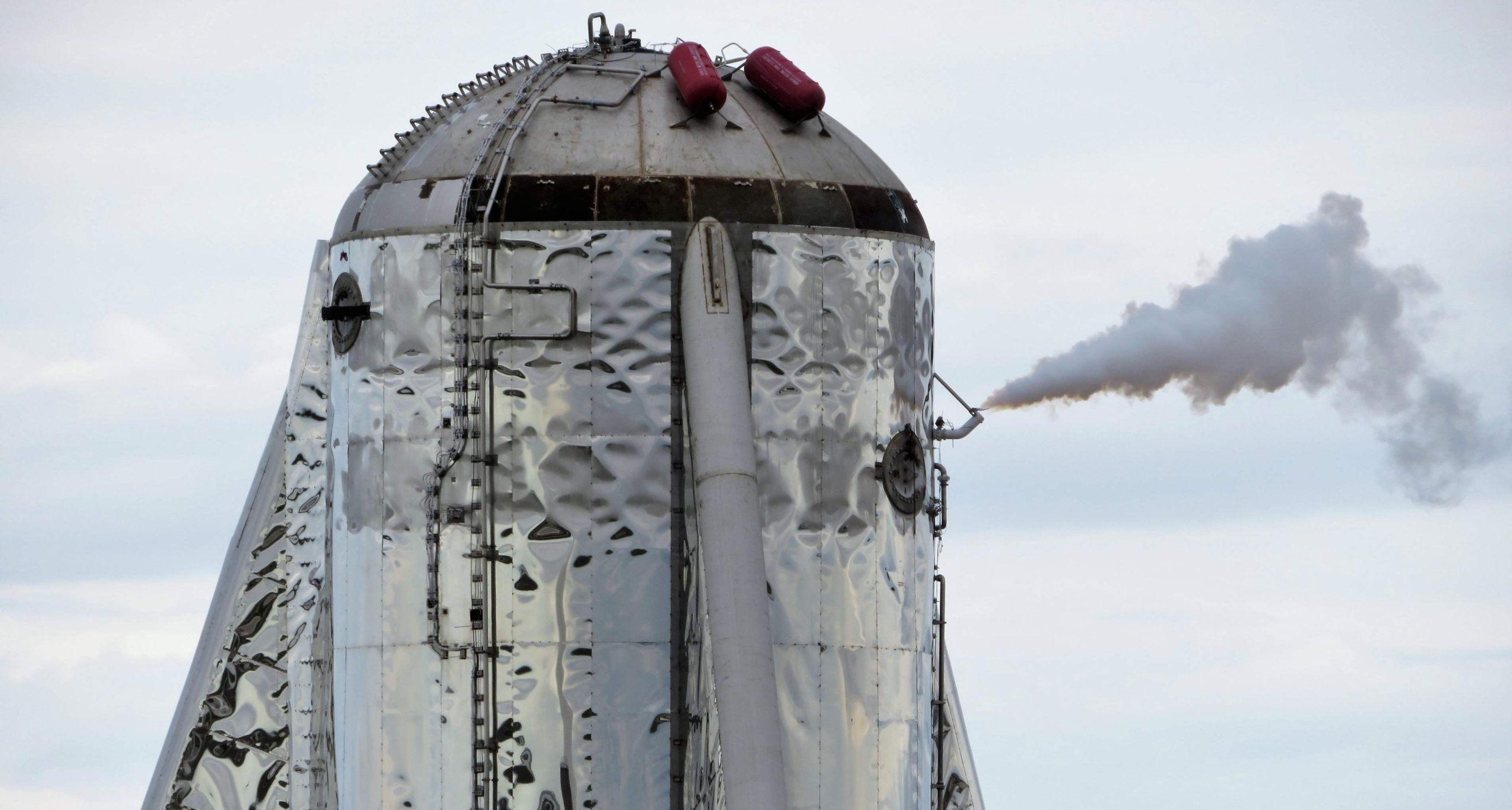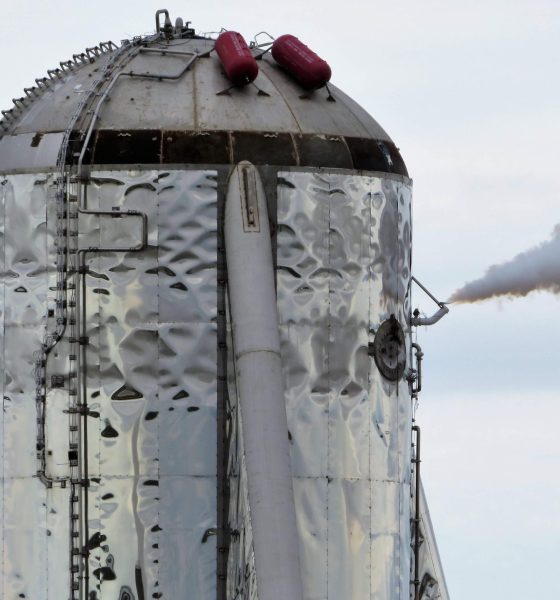

SpaceX
SpaceX’s Starship prototype set for first serious test after Raptor engine installed
In concert with South Texas’ Cameron County, SpaceX has officially scheduled the first serious test – requiring temporary road closures – of its Starship prototype, unofficially nicknamed ‘Starhopper’ in light of its ultimate goal of performing low-altitude, low-velocity hop tests.
SpaceX technicians have already successfully completed a number of unspecified tanking tests – likely with chemically neutral liquid nitrogen – and completed acceptance and installation of Raptor serial number 02 (SN02), setting the stage for the giant testbed’s first flight-critical tests. Now set to occur between
Scarcely seven days after the engine’s arrival in Boca Chica, SpaceX technicians completed the first-ever installation of a flight-ready Raptor – SN02 – on a full-scale BFR prototype known as Starhopper. Aside from marking a major symbolic milestone for the company’s next-generation rocket development program, the installation of a functional rocket engine on the first partial-fidelity vehicle prototype means that SpaceX can now enter into a new and critical stage of development: integrated flight testing.
Assuming (hopefully) that SpaceX has yet to conduct actual fueling tests of the Starship prototype without establishing roadblocks and safety perimeters, something that would be an egregious threat to nearby locals, it’s likely that this first major test – much like SpaceX’s established Falcon 9 and Heavy test regime – will involve a process known as a Wet Dress Rehearsal (WDR). A WDR would see Starhopper loaded with liquid methane and oxygen propellant – potentially anywhere from the bare minimum needed to operate a single Raptor to completely filling its tanks – to verify that the prototype’s complex plumbing system and giant tanks are operating nicely together under flight conditions (i.e. cryogenic temperatures, thermal and mechanical stresses, chemical environments, etc.). Much like routine Falcon 9 static fire tests performed both at SpaceX’s McGregor, TX test site and the launch pad, data indicating that the rocket is behaving nominally during the WDR allows the operations team to transition smoothly from a WDR into a captive static fire test, in which the vehicle’s engine(s) are briefly ignited to simulate the first few seconds prior to liftoff.
It’s relatively rare but not unusual for planned Falcon 9 or Heavy static fire tests to end during the WDR phase in cases where the launch team observes data that appears to be less than nominal. SpaceX generally takes a “better safe than sorry” approach to these sorts of operations, swallowing the costs and risk of raising customers’ ire due to delays in order to ensure the highest probability of complete launch success.
For a vehicle as utterly new and alien as Starhopper is to both SpaceX and the aerospace industry as a whole, it’s safe to say that that tendency towards caution will be readily on display throughout these first several tests, at least until the company’s operations technicians and engineers are considerably more familiar with the prototype rocket’s behavior. On the other hand, given just how shoestring the budget of this beast likely is and how rapidly SpaceX managed to go from an empty dirt lot to a hop-test-ready, 30ft/9m-diameter Starship prototype, it’s equally likely that the company – particularly CEO Elon Musk – will accept the increased risk of catastrophic vehicle failures to keep the development program as agile as possible.


As Musk himself frequently and famously is known to say, it’s far better to push hardware to failure during early testing than it is to hold back and risk largely unplanned failures during nominal operations, a lesson that SpaceX itself has learned the hard way several times. One step further, while they are at best undeniably inconvenient and expensive, major vehicle failures during testing can actually be an invaluable source of data that ultimately improves the system as a whole. For BFR, a launch vehicle meant to safely, routinely, and reliably transport as many as 100+ people both around the Earth and solar system, all possible opportunities to learn and improve the system prior to risking the lives of passengers will be an absolute necessity if SpaceX wants to ensure that customers remain willing to trust the company and its spacecraft with their lives.
Check out Teslarati’s Marketplace! We offer Tesla accessories, including for the Tesla Cybertruck and Tesla Model 3.

News
SpaceX shades airline for seeking contract with Amazon’s Starlink rival

SpaceX employees, including its CEO Elon Musk, shaded American Airlines on social media this past weekend due to the company’s reported talks with Amazon’s Starlink rival, Leo.
Starlink has been adopted by several airlines, including United Airlines, Qatar Airways, Hawaiian Airlines, WestJet, Air France, airBaltic, and others. It has gained notoriety as an extremely solid, dependable, and reliable option for airline travel, as traditional options frequently cause users to lose connection to the internet.
Many airlines have made the switch, while others continue to mull the options available to them. American Airlines is one of them.
A report from Bloomberg indicates the airline is thinking of going with a Starlink rival owned by Amazon, called Leo. It was previously referred to as Project Kuiper.
American CEO Robert Isom said (via Bloomberg):
“While there’s Starlink, there are other low-Earth-orbit satellite opportunities that we can look at. We’re making sure that American is going to have what our customers need.”
Isom also said American has been in touch with Amazon about installing Leo on its aircraft, but he would not reveal the status of any discussions with the company.
The report caught the attention of Michael Nicolls, the Vice President of Starlink Engineering at SpaceX, who said:
“Only fly on airlines with good connectivity… and only one source of good connectivity at the moment…”
CEO Elon Musk replied to Nicolls by stating that American Airlines risks losing “a lot of customers if their connectivity solution fails.”
American Airlines will lose a lot of customers if their connectivity solution fails
— Elon Musk (@elonmusk) December 14, 2025
There are over 8,000 Starlink satellites in orbit currently, offering internet coverage in over 150 countries and territories globally. SpaceX expands its array of satellites nearly every week with launches from California and Florida, aiming to offer internet access to everyone across the globe.
Currently, the company is focusing on expanding into new markets, such as Africa and Asia.
News
Tesla hints at Starlink integration with recent patent
“By employing polymer blends, some examples enable RF transmission from all the modules to satellites and other communication devices both inside and outside the vehicle.”

Tesla hinted at a potential Starlink internet terminal integration within its vehicles in a recent patent, which describes a vehicle roof assembly with integrated radio frequency (RF) transparency.
The patent, which is Pub. No U.S. 2025/0368267 describes a new vehicle roof that is made of RF-transparent polymer materials, allowing and “facilitating clear communication with external devices and satellites.”
Tesla believes that a new vehicle roof design, comprised of different materials than the standard metallic or glass elements used in cars today, would allow the company to integrate modern vehicular technologies, “particularly those requiring radio frequency transmission and reception.
Tesla has recently filed a US patent application on integrating RF transparent materials into the roof structure.
“facilitating clear communication with external devices and satellites”
Tesla fleet is getting @Starlink connectivity integration soon. LFG @Tesla @elonmusk… pic.twitter.com/bLa8YtPLd1
— Chansoo Byeon (@Chansoo) December 9, 2025
Instead of glass or metallic materials, Tesla says vehicles may benefit from high-strength polymer blends, such as Polycarbonate, Acrylonitrile Butadiene Styrene, or Acrylonitrile Styrene Acrylate.
These materials still provide ideal strength metrics for crashworthiness, stiffness for noise, vibration, and harshness control, and are compliant with head impact regulations.
They would also enable better performance with modern technologies, like internet terminals, which need an uninterrupted signal to satellites for maximum reception. Tesla writes in the patent:
“By employing polymer blends, some examples enable RF transmission from all the modules to satellites and other communication devices both inside and outside the vehicle.”

One of the challenges Tesla seems to be aware of with this type of roof design is the fact that it will still have to enable safety and keep that at the forefront of the design. As you can see in the illustration above, Tesla plans to use four layers to increase safety and rigidity, while also combating noise and vibration.
It notes in the patent that disclosed examples still meet the safety requirements outlined in the Federal Motor Vehicle Safety Standards (FMVSS).
Starlink integrated directly into Tesla vehicles would be a considerable advantage for owners. It would come with a handful of distinct advantages.
Initially, the inclusion of Starlink would completely eliminate cellular dead zones, something that is an issue, especially in rural areas. Starlink would provide connectivity in these remote regions and would ensure uninterrupted service during road trips and off-grid adventures.
It could also be a critical addition for Robotaxi, as it is crucial to have solid and reliable connectivity for remote monitoring and fleet management.
Starlink’s growing constellation, thanks to SpaceX’s routine and frequent launch schedule, will provide secure, stable, and reliable internet connectivity for Tesla vehicles.
Although many owners have already mounted Starlink Mini dishes under their glass roofs for a similar experience, it may be integrated directly into Teslas in the coming years, either as an upgrade or a standard feature.
Investor's Corner
SpaceX IPO is coming, CEO Elon Musk confirms
However, it appears Musk is ready for SpaceX to go public, as Ars Technica Senior Space Editor Eric Berger wrote an op-ed that indicated he thought SpaceX would go public soon. Musk replied, basically confirming it.

Elon Musk confirmed through a post on X that a SpaceX initial public offering (IPO) is on the way after hinting at it several times earlier this year.
It also comes one day after Bloomberg reported that SpaceX was aiming for a valuation of $1.5 trillion, adding that it wanted to raise $30 billion.
Musk has been transparent for most of the year that he wanted to try to figure out a way to get Tesla shareholders to invest in SpaceX, giving them access to the stock.
He has also recognized the issues of having a public stock, like litigation exposure, quarterly reporting pressures, and other inconveniences.
However, it appears Musk is ready for SpaceX to go public, as Ars Technica Senior Space Editor Eric Berger wrote an op-ed that indicated he thought SpaceX would go public soon.
Musk replied, basically confirming it:
As usual, Eric is accurate
— Elon Musk (@elonmusk) December 10, 2025
Berger believes the IPO would help support the need for $30 billion or more in capital needed to fund AI integration projects, such as space-based data centers and lunar satellite factories. Musk confirmed recently that SpaceX “will be doing” data centers in orbit.
AI appears to be a “key part” of SpaceX getting to Musk, Berger also wrote. When writing about whether or not Optimus is a viable project and product for the company, he says that none of that matters. Musk thinks it is, and that’s all that matters.
It seems like Musk has certainly mulled something this big for a very long time, and the idea of taking SpaceX public is not just likely; it is necessary for the company to get to Mars.
The details of when SpaceX will finally hit that public status are not known. Many of the reports that came out over the past few days indicate it would happen in 2026, so sooner rather than later.
But there are a lot of things on Musk’s plate early next year, especially with Cybercab production, the potential launch of Unsupervised Full Self-Driving, and the Roadster unveiling, all planned for Q1.








